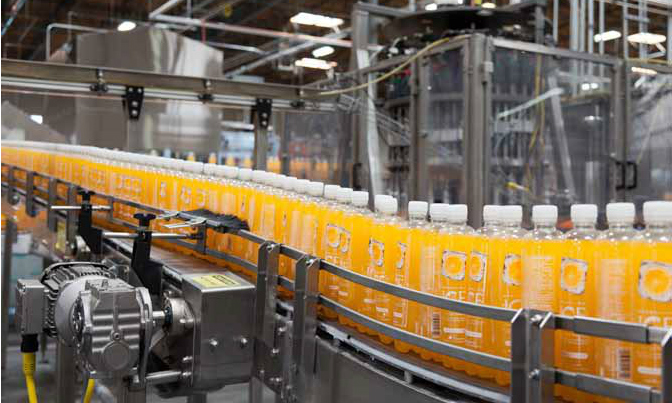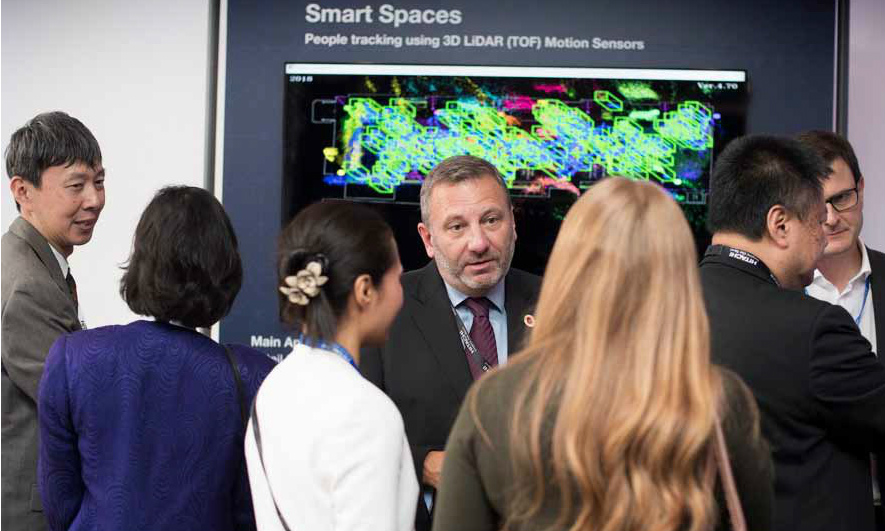Hitachi Social Innovation Forum 2018 - Empowering with data
Four hundred and seventy-five business leaders met in London earlier this month as part of a showcase of Hitachi IoT technologies across UK, European and global markets. If there was a takeaway from this social innovation forum at Glaziers Hall, it was how Hitachi divisions create practical innovations with immediate tangible benefits. Multiple case studies and product presentations illustrated how the company’s technology is benefiting end-users across safety, security and facility management.
In Security watched demonstrations of the 3D LiDAR (TOF) Motion Sensor which can report on individual movement, movement trends, and unusual situations in commercial and public spaces that may pose a potential threat. The sensors deliver actionable information while preserving anonymity and privacy. The 3D LIDAR (TOF) Sensor exploits multiple frames of IR light (up to 30 per second) and measures the time taken (‘Time of Flight TOF) between sensor to object and back. Individual objects can be tracked, and an application programme interface (API) presents data from multiple sensors at major sites to show aggregated activity and patterns.
3D LiDAR (TOF) Sensor has a major role to play in retail by monitoring and reporting upon unusual customer behaviours centred around checkout-free shopping. Several major UK supermarkets now allow regular customers to use scanner guns in order to streamline their purchasing experience in store, scanning product barcodes before putting items straight into their bag, paying for them automatically and so avoiding checkout queues. Use of mobile phones rather than the dedicated scanners could be a game changer and take the approach to a new level, a concept already being trialled by some.
While retailers are keen to increase the roll-out of this method, they can now look to sensing technology to protect them from shrinkage by correlating the number of items scanned with the number of items which are placed in the bag, as well as alerting on any atypical movement that might suggest theft. With no human agency at the initial stage (prior to intervention by store staff) and no facial image, the technology is immune to charges of social bias. Many industry observers now see the traditional grocery checkout experience as archaic but retailers have delayed implementing scanner guns until they can be confident that there is adequate protection against shrinkage.
Staying with retail, McKinsey & Company predicts that even as the boom in online retail continues, 80 percent of all purchases in 2020 will still be made in a traditional bricks-and-mortar shop. The buzz-phrase is Online-to-Offline Commerce, with customers visiting a store armed with information they have acquired online or inspired by an online advert.
But Online-to Offline has quickly become a misnomer. Farsighted retailers have already realised that the information can flow in both directions. Shoppers visiting a physical store who identify themselves at the entrance with a loyalty card can be tracked (in a non-invasive manner) by Hitachi ToF LIDAR.
Intelligent shelf technology with merchandised shelf edges and intelligent labelling (Intelligent LabelTM) logs their dwell-time at certain displays and if they do not purchase a product, the retailer can target them later with sales material. This could be by email or social ads and might cover price reductions, saving on multiple purchases or independent product reviews.
Hitachi also reports demonstrable success in using the technology to make intelligent suggestions about complementary purchases that give retailers rapid return on investment (ROI). Sensors as sophisticated as this are contributing to a reinvention of retail whereby the division between the digital marketplace and a traditional store is so blurred they can be treated as one and the same.
IR-based motion-sensing can be used to replicate the functionality of machine vision closed circuit television with major cost savings and increased reliability. Immediate application sectors that Hitachi is targeting include automated inspection on assembly lines and food production where safety is at a premium. 3D-LiDAR can guard against deliberate tampering by disaffected employees in the food sector as well as alerting on accidental dropping of foreign objects by staff and poor maintenance such as infrequent cleaning.
Applications of 3D LiDAR (TOF) Sensor range from the most granular detail to cumulative activity across major infrastructure. Current case studies include installation of the sensors on exit and entrance points of all kinds at an Italian city that receives 20 million visitors a year. The locations include a passenger marine terminal, airport and railway station as well as road crossings that can log passengers in coaches, cars and taxis. While the simple counting exercises are significant, of far more value to the city authority are trends across time periods and splits between different modes of transport. The 3D LIDAR (TOF) Sensor is helping local government to better understand visitor movement and so optimize infrastructure.
The sensors can give a macro view of a city as in this installation but they can also identify and reduce specific threats. IR motion-sensing is far more robust for people-counting than video analytics working from surveillance cameras. Sensors can be used for queue and spectator management, and the API excels in giving early warning of build-up of people and pinch-points so allowing police and marshals to intervene.
Empowering users with the best possible data to make the best possible decisions in mission-critical environments is a stated aim across the many divisions of Hitachi. Crucially, the API can use data from average activity (perhaps a standard day at a shopping centre or low-key event at a stadium) to prewarn police and stewards as to what to expect during a major public holiday or headliner concert. The API can display data as bar graphs, histograms and pie charts as well as heatmaps which are the most popular display choice.
3D LiDAR (TOF) is not solely about trends and it can protect against specific one-off problems. A common scenario is a suspicious object at a transport hub. The API’s knowledge of ambient movement in such a location will flag a suitcase being static for more than a few minutes as unusual. The artificial intelligence also recognizes that a suitcase should be accompanied by a passenger. Alerting on a piece of baggage that is any way unusual is a robust core function of the 3D LiDAR software. A common scenario is that once a sensor has highlighted a suspicious item, security staff use a robot equipped with a CCTV camera to allay fears about the object while taking minimal risks.
Hitachi’s current distribution model is to communicate the benefits and potential of 3D LiDAR (TOF) to end-users who in turn request installation from security or M&E contractors. 3D LIDAR (TOF) Motion Sensor is usually offered as a managed package. As usage examples proliferate and these are communicated to the market, integrators may start to assess suitable sites and be proactive in offering the product. 3D LiDAR (TOF) will be demonstrated at seminars, conferences and exhibitions in security, FM, IoT and vertical sectors throughout 2019.


